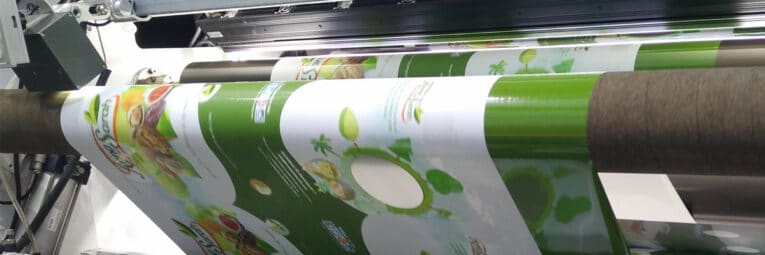
- Home
- All Posts
- Rewinding Technology
- Roll Hardness in Printing Film Slitter Rewinder
Blog

Roll Hardness in Printing Film Slitter Rewinder
Printing film slitter rewinder is a kind of converting machine which is widely used in laminating packaging, aluminum coating, cigarette packing, printing,etc. There are many factors affecting the quality of color printing film rolls, winding hardness is an important aspect. Keeping a proper tightness, not onlydirectly affects the winding of plastic film, but also is critical to the quality of the finished coils.
Measuring methods for roll hardness of printing film
1) Finger pressing method. Operators squeeze the surface or end face of the roll with their fingers to simply judge whether the tightness is appropriate. This method requests that workers are familiar with the hardness of the qualified finished rolls. However, the disadvantages are that there may be deviation caused by the subjective experience, lack of data support, and it is impossible to make any standardized records.
2) Observe the end face. Experienced operators from LEAP can find out the winding problems by color shades and patterns of the end face of printed film rolls. Generally speaking, the tighter the winding process, the darker the color of the end face, especially for inner area which is close to paper core. Star shaped wrinkle issues are generally caused by internal looseness and external tightness. In general, this method can make rapid and accurate judgment, but only proper for individual problems.
3) Hardness testing. Measure the surface of the film rolls by instruments, quantify the hardness index and record the datas to eliminate subjective factors. However, the limitation of this method is that it can only test the surface of printed plastic film rolls , and hard to reflect issues inside the plastic rolls.
4) Tap during winding process. During the running period of the color printing film slitter rewinders, tap the web materials in winding process with hands or other objects, to judge the tightness through feeling or sound. This method is widely used in practice because it can immediately find the internal and external problems of the coils, but for some films with bright surfaces, it’s necessary to pay attention to avoid damages to the film materials.
Problems caused by winding hardness of printing films
The roll hardness of printed films depends on many factors including the parameter setting of slitter rewinder, the physical properties of printing film, winding speed, the proficiency level of operators, work assessment and so on. Both too loose and too tight will affect the quality of finished film rolls.
When winding rolls with good tightness, the fluctuation of material thickness will not affect the winding process of slitting rewinding machines. When printing film is wound too tightly, due to its own tolerance problem, the thicker parts are superimposed and form bulg in the winding process to affect the roll quality. This slight deviation is often difficult to discover in the slitting and rewinding process. Too tight winding may also lead to adhesion issues for some color printing films or primer products with high surface tension, and further to result in falling off printing patterns and eventually scrapped. In addition, if the surface of the paper core is too rough, initial wrinkles or pits may appear due to too tight winding problems.
During the high-speed operation of color printing film slitter rewinder machine, loose winding of film roll will cause movement of layers or Irregular end face. In addition, the layers near the paper core may be pulled out during removals, greatly affect appearance and quality. Too loose winding will also lead to wrinkles and star shaped or fish scale shaped patterns on end face of printing film rolls. The phenomenon of eccentric winding is also caused by too loose winding, which makes the roll materials into an oval shape, and uneven tension occurs during unwinding process.
Use principle of printing film slitter rewinder
1) Optimize the slitting process. The operator of the slitting rewinding machine should decide proper slitting process according to the influence of the hardness factors on printed films with different purposes, constantly summarize datas in practice, and adjust the tightness as needed to meet the requirements of the products.
2) Rather be loose than tight. Due to some limitations of objective factors such as the performance of slitting rewinding equipment, product specification requirements, film properties, etc, the roll hardness cannot be acheive ideal state. Usually we follow the principle of “loose is better”, because the problems caused by too tight winding process are likely to lead to mor waste roll materials.
3) Perfect system management. The property, length and width of various film materials should be matching with the tension, pressure and variable parameters of printing film slitter rewinder, and record the the best solution, as a guidance document for subsequent cutting and training work. On this basis, The record should be continuously optimized and improved in combination with practice. Try to reduce the influence of deviation of personal subjective ability on printing film quality.
About Lvjie
Serch
Recent Posts
-
Overview of UHMWPE Separato... September 20, 2024
-
Overview of PVC Slitter Rew... July 2, 2024
-
Overview of Pre-coated Film... April 25, 2024
-
Overview of stretch film sl... March 11, 2024
-
Application of BOPP Tape Sl... November 29, 2023
Categories
- All Posts (28)
- Others (1)
- Unwinding Technology (3)
- Rewinding Technology (7)
- Slitting System (18)
- Control System (4)
Contact Info

Xiongzhou Street, Liuhe District, Nanjing City, 211511, China
Phone: 86 025 86555699Email: info@film-slitter.com
Recent Posts
-
Overview of UHMWPE Separato... September 20, 2024
-
Overview of PVC Slitter Rew... July 2, 2024
-
Overview of Pre-coated Film... April 25, 2024
-
Overview of stretch film sl... March 11, 2024
-
Application of BOPP Tape Sl... November 29, 2023
